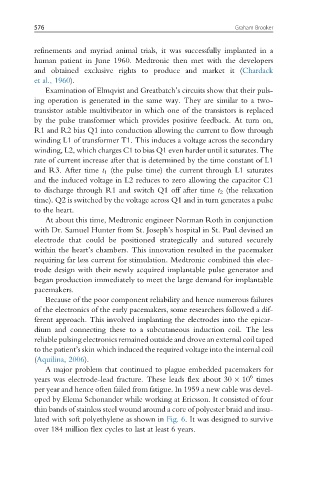Page 584 - Handbook of Biomechatronics
P. 584
576 Graham Brooker
refinements and myriad animal trials, it was successfully implanted in a
human patient in June 1960. Medtronic then met with the developers
and obtained exclusive rights to produce and market it (Chardack
et al., 1960).
Examination of Elmqvist and Greatbatch’s circuits show that their puls-
ing operation is generated in the same way. They are similar to a two-
transistor astable multivibrator in which one of the transistors is replaced
by the pulse transformer which provides positive feedback. At turn on,
R1 and R2 bias Q1 into conduction allowing the current to flow through
winding L1 of transformer T1. This induces a voltage across the secondary
winding, L2, which charges C1 to bias Q1 even harder until it saturates. The
rate of current increase after that is determined by the time constant of L1
and R3. After time t 1 (the pulse time) the current through L1 saturates
and the induced voltage in L2 reduces to zero allowing the capacitor C1
to discharge through R1 and switch Q1 off after time t 2 (the relaxation
time). Q2 is switched by the voltage across Q1 and in turn generates a pulse
to the heart.
At about this time, Medtronic engineer Norman Roth in conjunction
with Dr. Samuel Hunter from St. Joseph’s hospital in St. Paul devised an
electrode that could be positioned strategically and sutured securely
within the heart’s chambers. This innovation resulted in the pacemaker
requiring far less current for stimulation. Medtronic combined this elec-
trode design with their newly acquired implantable pulse generator and
began production immediately to meet the large demand for implantable
pacemakers.
Because of the poor component reliability and hence numerous failures
of the electronics of the early pacemakers, some researchers followed a dif-
ferent approach. This involved implanting the electrodes into the epicar-
dium and connecting these to a subcutaneous induction coil. The less
reliable pulsing electronics remained outside and drove an external coil taped
to the patient’s skin which induced the required voltage into the internal coil
(Aquilina, 2006).
A major problem that continued to plague embedded pacemakers for
6
years was electrode-lead fracture. These leads flex about 30 10 times
per year and hence often failed from fatigue. In 1959 a new cable was devel-
oped by Elema Schonander while working at Ericsson. It consisted of four
thin bands of stainless steel wound around a core of polyester braid and insu-
lated with soft polyethylene as shown in Fig. 6. It was designed to survive
over 184 million flex cycles to last at least 6 years.

